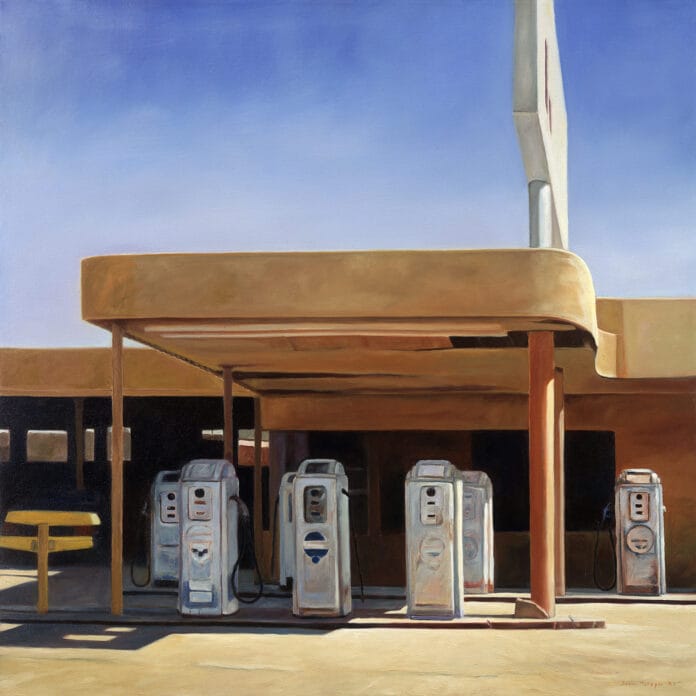Steve Metzger’s life in art began before he ever held a brush. Born in Duluth, Minnesota, he was raised in a home where art was more than a pastime; it was a way of life. His parents met at the Kansas City Art Institute, his mother studying sculpture on a scholarship, and his father pursuing commercial art through the GI Bill. Growing up in such a creative environment laid the foundation for Metzger’s lifelong exploration of the arts.
By the age of 10, he had already begun learning upright bass, marking the beginning of his dual identity as both a musician and visual artist. Yet, it wasn’t until the summer after his sophomore year of high school that he picked up a paintbrush and discovered the expressive potential of visual storytelling.
California Inspirations and Artistic Discovery
During the 1970s, Metzger attended Fullerton College (then Fullerton Junior College), focusing on the arts. It was during this time that he found inspiration in the vibrant Southern California art scene. Frequent visits to local institutions like The Newport Museum in the Pavilion, the Jack Glenn Gallery, and the pioneering Newspace in Newport Beach exposed him to contemporary movements and the power of modern visual language.
He soon enrolled at California State University, Fullerton, where he deepened his study of art and received his MFA in 1986. This academic foundation equipped him with technical skills and conceptual depth, laying the groundwork for a prolific career as an artist, educator, and musician.
A Multifaceted Creative Practice
Throughout his life, Steve Metzger has embraced a wide range of artistic disciplines, including music, painting, sculpture, drawing, printmaking, and mixed media. His identity, however, remains grounded in being what he calls a musician-painter, a term that speaks to the rhythm and emotional cadence that infuse his work.
Though primarily known for his paintings, Metzger has also completed four public sculptures, demonstrating his ability to translate ideas into three-dimensional form. His multidisciplinary practice is united by an interest in surface, texture, and time, qualities that appear consistently in his visual work regardless of medium.
From Abstraction to Observation
For many years, Metzger focused on non-objective, abstract painting, works that explored form, color, and emotional expression without representational imagery. Over time, however, his attention shifted toward the world around him. He began painting from photographs he took himself, drawn to images that held personal and aesthetic significance.
His subjects are often overlooked yet quietly evocative: abandoned buildings, weathered gas stations, traditional still-life compositions, roadside scenes, and decaying landscapes. These are not mere depictions of forgotten places; they are meditations on time, memory, and presence.
Desert Center Gas Station: Painting Memory into Place
One of Metzger’s notable pieces, Desert Center Gas Station, exemplifies his evolving approach. The work is part of an ongoing series focused on abandoned structures, painted not as romantic relics of the past, but as physical records of time’s relentless passage.
In his statement of intent, Metzger reflects, At first, I liked the subject matter, the surfaces, textures, locations, and the light. Now, I would add concerns with entropy and the passing of time, rather than nostalgia. His work avoids sentimental longing; instead, it contemplates the beauty and inevitability of decay.
The painting is grounded in direct observation. Metzger takes photographs during road trips, often accompanied by his wife, Jamie, and uses them as reference material. The process becomes layered with meaning: each painting encapsulates not just a place, but the memory of the journey, the tools used, and the act of creation itself.
Music, Memory, and Meaning
Music and painting are not separate endeavors for Metzger. They often intersect literally in exhibitions where he performs his original songs amid the paintings on display. The interplay between the visual and auditory creates an immersive atmosphere where themes of travel, transience, and observation echo across media.
There’s a connection between the paintings and the songs I write and perform, he notes. They seem to go together. This creative synthesis brings added depth to both forms, as the artwork and music reflect on each other and the memories embedded within.
A Living Archive of the Forgotten
In recent years, Metzger has begun revisiting older photographs and previous works, using them as starting points for new paintings. This cyclical return to earlier images reinforces his interest in time, memory, and transformation. Many of the buildings he once photographed no longer exist, preserved only in paint and pixels.
His work resists the notion of art as static. Instead, it is alive with layers of past experience, trips taken, songs written, brushes handled, and canvases stretched. As Metzger puts it, Some of the buildings only remain in my paintings and photos. The act of painting becomes a form of quiet preservation, a way to honor impermanence without clinging to it.
Conclusion: The Ongoing Journey of Steve Metzger
Steve Metzger’s artistic life defies categorization. Rooted in early family influences and shaped by decades of exploration, his work offers a unique blend of musical sensibility, visual storytelling, and philosophical reflection. Whether painting forgotten gas stations or performing original music, Metzger invites his audience to pause, reflect, and see the world and themselves through a more textured lens.
In the silence of abandoned buildings and the hum of a bassline, his art reminds us that beauty is often found not in what remains perfect, but in what endures.


